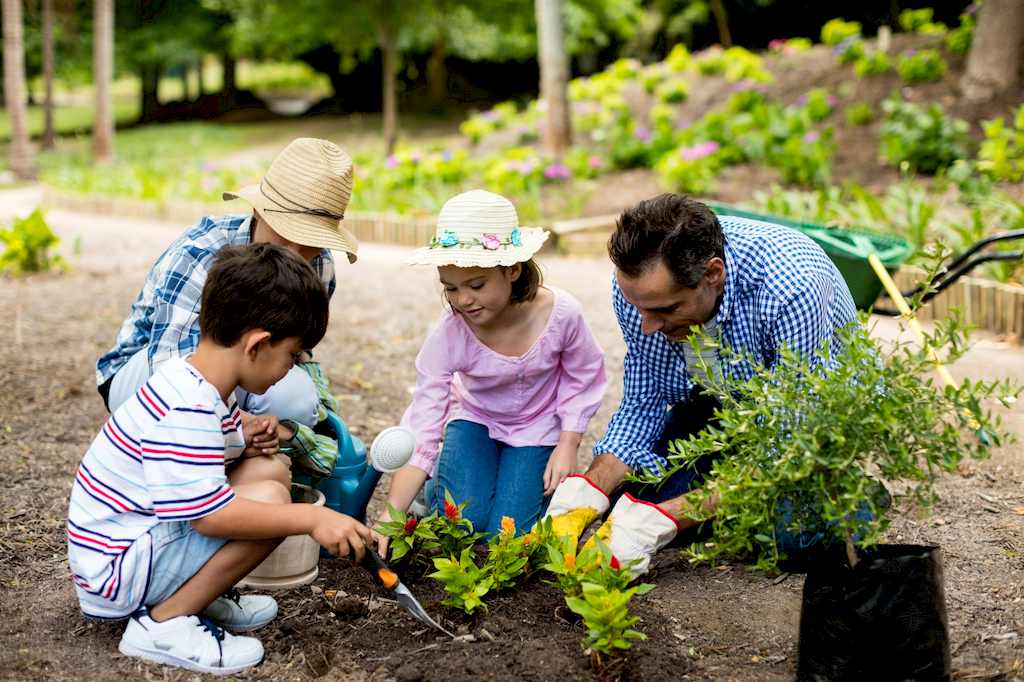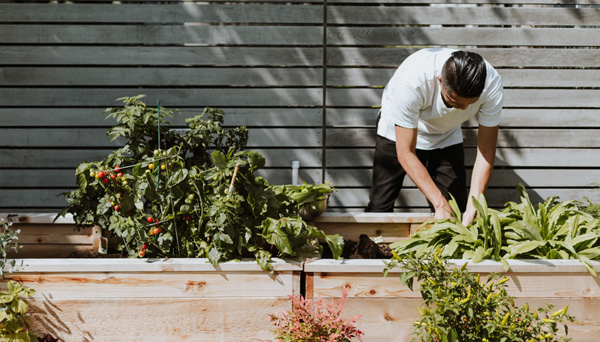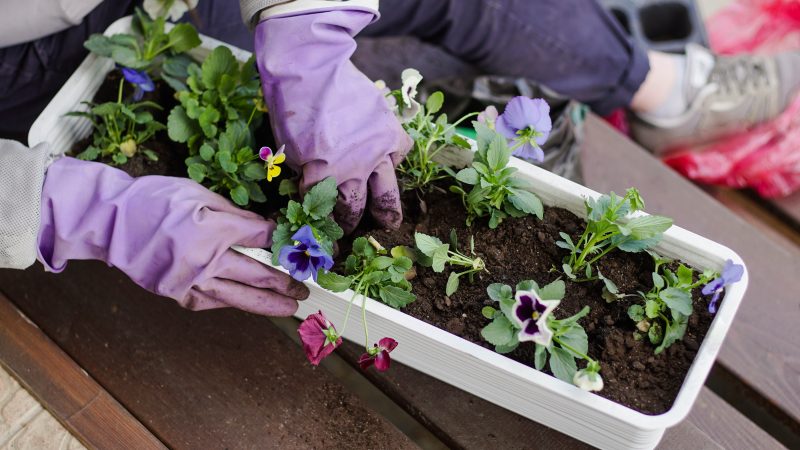Tips To Maintain Your Garden At Home

Gardening is the act of taking care of and growing plants, whether for useful reasons like growing veggies or for beautiful reasons like flowering plants. Getting involved in gardening is a fun and satisfying way to connect with nature and make your own little green spaces. Small gardens, like pots and planters on a rooftop, are one way to garden. Larger gardens are another way to garden. No matter what size garden you have, you need to know the basics and give your plants regular care to make sure they stay healthy. Anyone can have a beautiful and successful garden as long as they keep up with it and use the right methods. We will look at some tips and rules that will help you keep your home garden healthy and growing in the parts that follow.
Benefits of Gardening
You can get a lot of benefits from gardening besides just making your garden look nicer. It is not only a great way to reduce stress, but it is also a great way to stay active. Gardening can help you feel better mentally, lower your stress, and relax more generally.
Aside from the health benefits, gardening is also good for the earth. By making your own green haven, you are helping to protect wildlife. Pollinators and other good bugs are drawn to the plants and flowers in your garden. These bugs are important for keeping ecosystems balanced. Using organic matter and taking good care of your garden can also help clean up the air and cut down on pollution.
You can grow your own food, which is another big benefit of gardening. This not only lets you enjoy the thrill of picking your own food, but it also makes sure you can get healthy, organic fruits and veggies. From seed packs to flowering gardens and bumper crops, seeing your plants grow is a satisfying experience.
Prepare the Soil
A very important part of keeping a garden healthy is getting the dirt ready. It’s important to make sure the soil is full of organic matter and has all the nutrients plants need before putting seeds or seedlings. First, clean up the garden beds by getting rid of any trash or weeds. Next, add organic matter to the soil, like compost or well-rotted dung, to make it better for plants and animals. This will give the plants the nutrients they need and help the soil keep its wetness. It can also be helpful to check the pH of the soil, since different plants like different pH levels. By adjusting the pH levels correctly, you can give your plants the best conditions for growth. Lastly, make sure the dirt doesn’t have any places that are packed down and doesn’t drain well. This will help the roots grow in a healthy way and keep them from getting too wet, which can cause root rot and other plant diseases. If you take the time to prepare the dirt correctly, you will have a garden that grows well.
Test the Soil Quality
A very important part of keeping a garden healthy is testing the soil. You can find out about the soil’s pH levels, nutrients, and health in general by checking it. That knowledge is very important because it lets you make the changes you need to make to give your plants the best conditions possible.
You can test the dirt in a number of different ways. You could use a soil measuring kit, which usually comes with a pH tool and colour-coded markers for different mineral amounts. It’s simple to use these kits, and they work right away. You could also send a sample of dirt to a lab for a more in-depth study. This method lets you get a full picture of the soil’s makeup, including its macro and micronutrients.
It is important to know the pH levels of your soil because they affect how well plants can take nutrients. Too high or too low of a pH can make it hard for nutrients to reach plants and stop them from growing. Testing the soil’s nutrient content also lets you know if there are any shortages or surpluses that need to be fixed with fertiliser or other changes.
Add Organic Matter to the Soil
Adding organic matter to the soil is an important part of keeping a garden healthy. Organic matter, like fertiliser, dung, and leaf litter, makes the soil more fertile and stable, giving plants the nutrients they need to grow.
Organic matter is good for soil nutrition because it has nutrients like nitrogen, phosphorus, and potassium that plants need. As the organic matter breaks down, these nutrients are slowly released, making sure that the plants always have enough.
Also, organic matter improves the structure of the soil by making it better at holding water and nutrients. It also encourages the formation of clumps, which make pores that let more air flow and help roots grow.
You can make compost from food scraps, yard trash and even chopped leaves. It is a great way to get organic matter. It adds important nutrients to the soil and helps it keep water in.
Adding manure is another great way to add organic matter. There are a lot of nutrients in it, like nitrogen, which helps plants grow quickly. But to keep your plants from getting burned, it’s best to use manure that has been aged or composted.
Leaf litter is a natural source of organic matter that is easy to work into the ground. When the leaves fall in your garden in late winter or early spring, pick them up and either spread them out as mulch or mix them into the soil. When the leaves break down, they release nutrients into the soil and make it stronger.
By adding organic matter to your soil, you can make sure that it has the right amount of nutrients and structure for plants to grow well.
Improve Soil Structure and Texture
Improving the structure and quality of the soil is an important part of keeping a garden healthy. Soil that is packed down makes it harder for plants to grow because they can’t absorb as much air and nutrients. It’s important to soften the dirt so that your plants can grow in the best way possible.
Tilling is a good way to improve the structure of soil over bigger areas. A rototiller is used to break up the packed-down dirt and allow more air to flow through it. This process helps make pores, which let plant roots spread out and get to nutrients they need.
Core aerating is a good way to improve the health of grass. Small bits of dirt are taken out of the ground to let air, water, and nutrients get into the soil. Core aeration helps keep the soil from getting too compacted and encourages healthy plant growth for a lush, green yard.
You can make a place for plants to grow well by changing the structure and texture of the dirt. For plants to grow in a healthy way, they need to get enough air, nutrients, and roots to grow. Using these techniques, whether you choose tilling or core aerating, will make the soil better and help your garden grow.
How to Choose and Place Plants
When you’re taking care of your own garden, picking the right plants and putting them in the right places can make all the difference. By choosing the right plants for your garden, you can be sure that they will do well there and need little care. Putting plants in the right places in your garden can also help them get the most sunshine and make the scenery look nice. To help you keep your garden healthy and beautiful, here are some tips on how to choose plants and put them in the ground.
Plant Choice and Placement
Getting the right plants is important for making a low-maintenance home garden. Spider plants, money plants, and snake plants are all great options for people who want plants that don’t need much care.
Spider plants (Chlorophytum comosum) have long, arched leaves and stems that look like spider webs. They are very tough and can grow in a lot of different light situations, from low light to bright indirect light. Spider plants also don’t need much water, which makes them great for people who are busy or who forget to water their plants often.
Money plants, which are also called Devil’s Ivy (Epipremnum aureum), are very flexible and can do well in a wide range of conditions. They have shiny, heart-shaped leaves that make any room, indoors or out, look more elegant. People often say that money plants clean the air, and because they can handle less light, they can be grown in places that don’t get much sun.
People like snake plants (Sansevieria trifasciata) because they have beautiful, sword-shaped leaves and can live in almost any environment. Because these plants don’t need much water or light, they’re great for people who are just starting out or who are always on the go.
If you choose spider plants, money plants, or snake plants for your garden, you can enjoy the beauty of plants with little work. These plants don’t need much care and will do well in a wide range of environments, so even a beginner grower can grow them.
Select Appropriate Plant Beds and Containers
If you want your plants to do well in home gardening, you need to choose the right plant beds and pots. Here are some choices to think about:
- Raised Beds: Gardeners like raised beds because they give them more control over the quality and amount of wetness in the soil. They also make it easier to get rid of weeds and can be made from different materials, such as stone or wood.
- Planter Boxes: Planter boxes are flexible and can be put in many places, like on a porch or a balcony. They come in many shapes and sizes and can be used to grow many types of plants, from veggies to flowers.
- Hanging Baskets: Hanging baskets are great for vertical gardening or small areas. They make your garden look more interesting because they let plants fall over them. Pick baskets that are light and easy to hang, and make sure they can drain well.
- Garden Pots: Garden pots are a traditional container growing option. You can get them made of clay, pottery, plastic, or other materials. Make sure the pots are the right size for your plants and have holes in them for ventilation.
Think about the size and room your plants need when choosing a plant bed or pot. Some plants need more space for their roots to grow, while others do better in smaller areas. Think about what your plants need in terms of water, sunshine, and the quality of the dirt. You can make sure your plants have the best place to grow by choosing the right plant beds and pots.
Place Plants in Direct Sunlight or Shade, as Needed
For plants to grow and develop properly, they need to be in the right amount of sunlight. Photosynthesis, the process by which plants turn light into energy, can’t happen without sunshine. Because of this, it’s important to give plants the right amount of direct sunlight every day.
Some plants do better in full sun, while others do better in the shade. When you choose plants for your garden, you should make sure they can grow in the light that is there. Checking the directions on seed packs or plant stickers is the best way to find out how much light a plant needs. You can also look at the plant in its natural environment to get an idea of the light it likes.
Most plants that need straight sunshine need at least 6 hours of sunlight every day. Most veggies, herbs, and blooming plants are in this group. For plants that like shade, on the other hand, you should put them somewhere with indirect sunshine or not much direct sunlight. Some of these plants are ferns, hostas, and some types of blooming perennials.
This will help your plants grow and do well. Make sure they get the right amount of sunshine, either straight or indirect. So, learn about how much light your plants need and put them where they will get it for a healthy, happy garden.
Space Plants Appropriately for Healthy Growth and Development
Plants need to be spaced out correctly in your garden so they can grow and develop in a healthy way. Each plant needs space for its roots to spread out and for enough sunshine to reach them. You can help your plants grow and reach their full potential by giving them the room they need.
Think about how far apart your plants will grow when they’re fully grown. Some plants, like some types of pumpkins or peppers, can get pretty big, so make sure there is a lot of space between them. On the other hand, you can put greens or flowers closer together than bigger plants.
Also, think about how each plant grows. Flower or herb types that grow in a thick style can spread out and need more space between them. Some plants, like beans that grow up vertically or climbers like cucumber, might do better with the help of trellises or stakes, and they can be put closer together.
For exact spacing suggestions, it’s always a good idea to look at planting tips or seed packages. These rules are usually based on the plant’s full size and how it grows, and they can help you figure out how far apart to put the plants.
Leaving enough room between your plants lets air move, lowers the risk of diseases, and gives them enough sunshine for growth. By following these tips and giving your plants the room they need, you can have a healthy garden full of plants that are doing well and producing lots of food or pretty flowers.
Watering Tips for Home Gardens
For plants in your home garden to stay healthy and strong, they need to be watered properly. Giving plants enough water helps them absorb nutrients and keeps them from drying out, which helps them grow and flower at their best. Here are some tips on how to water your garden so that it stays green and healthy. Plants that make food. Have fun planting!

Estimate Amount of Water per Plant
Figuring out how much water each plant in your garden needs is very important for keeping them healthy and growing well. You can make sure that each plant gets the right amount of water by thinking about things like the type of plant, the weather, and the level of moisture in the soil. Here are some tips to help you figure out how much water your plants need:
- Type of plant: Every plant needs a different amount of water. Do some research on your plant species to find out how much water they need. For instance, veggie plants usually need more water than cacti or plants that can survive in dry conditions.
- Conditions of the weather: Plants need more water when it’s hot and dry outside. Plants need to be watered more often when it’s hot outside or when it’s dry for a long time.
- Soil wetness levels: Make sure you check the soil’s moisture level often. Put your finger into the ground about an inch below the plant’s roots. It’s time to water if the ground feels dry. Don’t water it for a few more days if it feels wet.
- Look at the leaves of the plant. Leaves that are properly hydrated are green, shiny, and hard. Leaves that look faded, yellow, or droopy may mean that the plant isn’t getting enough water. Change the time you water your plants properly.
Remember to water deeply and not too often so that the water can reach the roots. You can help your plants grow and keep your garden healthy by figuring out how much water they need based on what they need.
Control Water Volume with Litres or Inches of Water
It is important to guess how much water each plant needs so that you can control the amount of water and make sure the plants in your home garden get enough water. To do this, you can look at the level of wetness in the earth and the amount of water that each type of plant needs.
Depending on a number of factors, you can choose to measure water in either litres or inches. If you want to use litres, you’ll have to guess how much water each plant needs based on what it needs and how wet the soil is. To do this, you can use your finger to check the amount of wetness and change the watering plan as needed.
If you measure in inches, on the other hand, you can guess how much water is needed by seeing how deep the water goes into the ground. Plants need about an inch of water every week, which helps make sure they stay properly hydrated. But this could be different based on things like the type of dirt, the plants that grow there, and the weather.
Don’t forget to think about how much water each plant needs. Some may need more than others. You can better meet the needs of your garden plants and keep your garden healthy by reducing the amount of water and keeping an eye on the soil’s wetness level.
Conclusion
In conclusion, giving your garden plants the right care and attention is a big part of making sure they grow well. For plants to be healthy, they need to be watered regularly, get enough sunshine, and get the nutrients they need. Furthermore, keeping the earth healthy by adding organic matter and covering it with mulch helps plants grow properly and stops weeds from growing.




